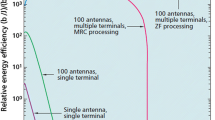Abstract
It is well known that the capacity of spatial multiplexing multiple-input multiple-output (SM-MIMO) system employing optimal antenna selection can significantly outperform a system without selection for same number of costly radio frequency chains. However, it requires an exhaustive search for the optimal selection (OS) that grows exponentially with the available number of transmit (u) and receive (m) antennas. In this paper, a novel low complexity receive antenna selection (RAS) technique is proposed for SM-MIMO to maximize the channel capacity over correlated Rayleigh fading environment. It is based on the Euclidean norms of channel matrix rows and the corresponding phase differences due to their direct impact on the capacity. Extensive analysis and simulations have shown near optimal performance for any signal-to-noise-ratio and correlation values with low complexity of \({\mathcal{O} \left({u^{2}m}\right)}\) vector calculations. This technique provides fast RAS to capture most of the capacity gain promised by multiple antenna systems over different channel conditions. Furthermore, it enables efficient spectrum utilization for next generation wireless communications.
Similar content being viewed by others
References
Mietzner J., Schober R., Lampe L., Gerstacker W., Hoeher A. (2009) Multiple-antenna techniques for wireless communications—a comprehensive literature survey. IEEE Communications Surveys & Tutorials 11(2): 87–105
Paulraj A., Gore D., Nabar R., Bolcskei H. (2004) An overview of MIMO communications—a key to gigabit wireless. IEEE Proceedings 92(2): 198–218
Parkvall S., Furuskar A., Dahlman E. (2011) Evolution of LTE toward IMT-advanced. IEEE Communications Magazine 49(2): 84–91
Li Q., Furuskar A., Li G., Lee W., Lee M., Mazzarese D., Clerckx B., Li Z. (2010) MIMO techniques in WiMAX and LTE: A feature overview. IEEE Communications Magazine 48(5): 86–92
Akhtar J., Gesbert D. (2005) Spatial multiplexing over correlated MIMO channels with a closed-form precoder. IEEE Transactions on Wireless Communcations 4(5): 2400–2409
Molisch A., Win M. (2004) MIMO systems with antenna selection. IEEE Microwave Magazine 5(1): 46–56
Sanayei S., Nosratinia A. (2004) Antenna selection in MIMO systems. IEEE Communications Magazine 42(10): 68–73
Molisch A., Win M., Choi Y. S., Winters J. (2005) Capacity of MIMO systems with antenna selection. IEEE Transactions on Wireless Communications 4(4): 1759–1772
Gorokhov A., Gore D., Paulraj A. (2003) Receive antenna selection for MIMO spatial sultiplexing: Theory and algorithms. IEEE Transactions on Signal Processing 51(11): 2796–2807
Gharavi-Alkhansari M., Gershman A. (2004) Fast antenna subset selection in MIMO systems. IEEE Transactions on Signal Processing 52(2): 339–347
Jensen M., Morris M. (2005) Efficient capacity-based antenna selection for MIMO systems. IEEE Transactions on Vehicular Technology 54(1): 110–116
Zhang X., Molisch A., Kung S. Y. (2005) Variable-phase-shift-based RF-baseband codesign for MIMO antenna selection. IEEE Transactions on Signal Processing 53(11): 4091–4103
Zhang Y., Ji C., Malik W., O’Brien D., Edwards D. (2009) Receive antenna selection for MIMO systems over correlated fading channels. IEEE Transactions on Wireless Communications 8(9): 4393–4399
Narasimhan R. (2003) Spatial multiplexing with transmit antenna and constellation selection for correlated MIMO fading channels. IEEE Transactions on Wireless Communications 51(11): 2829–2838
Yang Y., Blum R., Sfar S. (2009) Antenna selection for MIMO systems with closely spaced antennas. EURASIP Journal On Wireless Communications and Networking 2009(ID739828): 1–11
Heath R. Jr., Sandhu S., Paulraj A. (2001) Antenna selection for spatial multiplexing systems with linear receivers. IEEE Communications Letters 5(4): 142–144
Wang B., Hui H., Leong M. (2010) Global and fast receiver antenna selection for MIMO systems. IEEE Transactions on Communications 58(9): 2505–2510
Dai L., Sfar S., Letaief K. (2006) Optimal antenna selection based on capacity maximization for MIMO systems in correlated channels. IEEE Transactions on Communications 54(3): 563–573
Karamalis P., Skentos N., Kanatas A. (2004) Selecting array configurations for MIMO systems: An evolutionary computation approach. IEEE Transactions on Wireless Communications 3(6): 1994–1998
Lu H. Y., Fang W. H. (2007) Joint transmit/receive antenna selection in MIMO systems based on the priority-based genetic algorithm. IEEE Antennas and Wireless Propogation Letters 6: 588–591
Lain J. K. (2011) Joint transmit/receive antenna selection for MIMO systems: A real-valued genetic approach. IEEE Communications Letters 15(1): 58–60
Soysal A., Ulukus S. (2010) Joint channel estimation and resource allocation for MIMO systems—partI: Single-user analysis. IEEE Transactions on Wireless Communications 9(2): 624–631
Sklar B. (1997) Rayleigh fading channels in mobile digital communication systems, part I: Characterization. IEEE Communications Magazine 35(7): 90–100
Alouini M., Goldsmith A. (1999) Capacity of Rayleigh fading channels under different adaptive transmission and diversity-combining techniques. IEEE Transactions on Vehicular Technology 48(4): 1165–1181
Al-Hussaibi W., Ali F. (2012) Generation of correlated Rayleigh fading channels for accurate simulation of promissing wireless communication systems. Elsevier Journal On: Simulation Modelling Practice and Theory 25(4): 56–72
Al-Hussaibi, W., & Ali, F. (2011). Iterative coloring technique for the generation of correlated Rayleigh fading envelopes for multi-antenna and multicarrier systems. In Proceedings of the 12th PGNet2011 (pp. 103-108), UK, June 2011.
Yoo T., Goldsmith A. (2005) Capacity and power allocation for fading MIMO channels with channel estimation error. IEEE Transactions on Information Theory 52(5): 2203–2214
Rizogiannis C., Kofidis E., Papadias C., Theodoridis S. (2010) Semi-blind maximum-likelihood joint channel/data estimation for correlated channels in multiuser MIMO networks. ELSEVIER Journal On Signal Processing 90: 1209–1224
Author information
Authors and Affiliations
Corresponding author
Rights and permissions
About this article
Cite this article
Al-Hussaibi, W.A., Ali, F.H. Fast Receive Antenna Selection for Spatial Multiplexing MIMO over Correlated Rayleigh Fading Channels. Wireless Pers Commun 70, 1243–1259 (2013). https://doi.org/10.1007/s11277-012-0745-9
Published:
Issue Date:
DOI: https://doi.org/10.1007/s11277-012-0745-9




